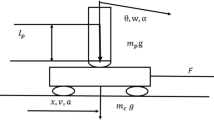Abstract
The control of bioprocesses can be very challenging due to the fact that these kinds of processes are highly affected by various sources of uncertainty like the intrinsic behavior of the used microorganisms. Due to the reason that these kinds of process uncertainties are not directly measureable in most cases, the overall control is either done manually because of the experience of the operator or intelligent expert systems are applied, e.g., on the basis of fuzzy logic theory. In the latter case, however, the control concept is mainly represented by using merely positive rules, e.g., “If A then do B”. As this is not straightforward with respect to the semantics of the human decision-making process that also includes negative experience in form of constraints or prohibitions, the incorporation of negative rules for process control based on fuzzy logic is emphasized. In this work, an approach of fuzzy logic control of the yeast propagation process based on a combination of positive and negative rules is presented. The process is guided along a reference trajectory for yeast cell concentration by alternating the process temperature. The incorporation of negative rules leads to a much more stable and accurate control of the process as the root mean squared error of reference trajectory and system response could be reduced by an average of 62.8 % compared to the controller using only positive rules.





Similar content being viewed by others
Abbreviations
- YCC:
-
Yeast cell concentration
- FLC:
-
Fuzzy logic controller
- RMSE:
-
Root mean squared error
- AFCE:
-
Absolute final control error
- P/N:
-
Positive/negative
References
Baruch IS, Hernandez SM (2011) Decentralized direct I-term fuzzy-neural control of an anaerobic digestion bioprocess plant. Comput Intell Control Autom (CICA) 2011:36–43. doi:10.1109/cica.2011.5945753
Hernandez SC, Sanchez EN, Beteau JF (2010) Fuzzy control strategy for an anaerobic wastewater treatment process
Hernandez SC, Sanchez EN, Beteau JF (2012) Fuzzy control structure for an anaerobic fluidised bed. Int J Control 85(12):1898–1912. doi:10.1080/00207179.2012.713514
Shu-Hsien L (2005) Expert system methodologies and applications—a decade review from 1995 to 2004. Expert Syst Appl 28(1):93–103. doi:10.1016/j.eswa.2004.08.003
Karakuzu C, Tuerker M, Oeztuerk S (2006) Modelling, on-line state estimation and fuzzy control of production scale fed-batch baker’s yeast fermentation. Control Eng Pract 14(8):959–974
Kasperski A, Miśkiewicz T (2002) An adaptive fuzzy logic controller using the respiratory quotient as an indicator of overdosage in the baker’s yeast process. Biotechnol Lett 24(1):17–21
Kiendl H (1997) Fuzzy control methodenorientiert. Oldenbourg, Munchen
Branson J, Lilly J Incorporation of negative rules into fuzzy inference systems. In: Decision and control, 1999. Proceedings of the 38th IEEE conference on. IEEE, New York, pp 5283–5288
Branson JS, Lilly JH (2001) Incorporation, characterization, and conversion of negative rules into fuzzy inference systems. Fuzzy Syst IEEE Trans 9(2):253–268
Lilly JH (2007) Evolution of a negative-rule fuzzy obstacle avoidance controller for an autonomous vehicle. Fuzzy Syst IEEE Trans 15(4):718–728
Kim J, An J (2011) A fuzzy obstacle avoidance controller using a lookup-table sharing method and its applications for mobile robots. Int J Adv Rob Syst 8(5):39–48
Jun W, Shitong W, F-I Chung (2011) Positive and negative fuzzy rule system, extreme learning machine and image classification. Int J Mach Learn Cybernet 2(4):261–271
Nguyen TM, Wu QJ A combination of positive and negative fuzzy rules for image classification problem. In: Machine learning and applications, 2008. ICMLA’08. Seventh international conference on, 2008. IEEE, New York, pp 741–746
Nguyen TM, Wu QJ (2010) Fuzzy system with positive and negative rules. INTECH Open Access Publisher
Kurz T (2002) Mathematically based management of Saccharomyces sp. batch propagations and fermentations. Dissertation. TU München, Freising
Pham HTB, Larsson G, Enfors S-O (1998) Growth and energy metabolism in aerobic fed-batch cultures of Saccharomyces cerevisiae: simulation and model verification. Biotechnol Bioeng 60(4):474–482
Sonnleitner B, Kaeppeli O (1986) Growth of Saccharomyces cerevisiae is controlled by its limited respiratory capacity: formulation and verification of a hypothesis. Biotechnol Bioeng 28(6):927–937
Sweere APJ, Giesselbach J, Barendse R, Krieger R, Honderd G, Luyben KCAM (1988) Modelling the dynamic behaviour of Saccharomyces cerevisiae and its application in control experiments. Appl Microbiol Biotechnol 28(2):116–127. doi:10.1007/bf00694298
Crabtree HG (1929) Observations on the carbohydrate metabolism of tumours. Biochem J 23(3):536
Ratkowsky D, Olley J, McMeekin T, Ball A (1982) Relationship between temperature and growth rate of bacterial cultures. J Bacteriol 149(1):1–5
Ratkowsky DALRK, McMeekin TA, Stokes AN, Chandler RE (1983) Model for bacterial culture growth rate throughout the entire biokinetic temperature range. J Bacteriol 154(3):1222
Hartmeier W (1972) Untersuchungen über die Kinetik der mikrobiellen Sauerstoff-Aufnahme und den Einfluß des Sauerstoff-Partialdruckes auf den Stoffwechsel von Saccharomyces cerevisiae. Ph.D. Thesis. Fachbereich Lebensmitteltechnologie und Biotechnologie: Technische Universität Berlin
Gschwend-Petrik M (1983) Dynamische Untersuchungen zur Stoffwechselregulation und Ethanolbildung bei Saccharomyces uvarum, vol 7441. Eidgenössische Technische Hochschule Zürich, Zurich
Cartwright CP, Rose AH, Calderbank J, Keenan MH (1989) Solute transport. The yeasts 3:5–56
Hutter A, Oliver S (1998) Ethanol production using nuclear petite yeast mutants. Appl Microbiol Biotechnol 49(5):511–516
Mamdani EH (1977) Application of fuzzy logic to approximate reasoning using linguistic synthesis. Comput IEEE Trans C-26(12):1182–1191
Mamdani EH (1976) Advances in the linguistic synthesis of fuzzy controllers. Int J Man Mach Stud 8(6):669–678
Passino KM, Yurkovich S, Reinfrank M (1998) Fuzzy control, vol 42. Citeseer
Acknowledgments
This work was supported by the Bayerische Forschungsstiftung Grant number AZ 994-11.
Author information
Authors and Affiliations
Corresponding author
Ethics declarations
Conflict of interest
The authors have declared no conflict of interest.
Rights and permissions
About this article
Cite this article
Birle, S., Hussein, M.A. & Becker, T. Incorporation of negative rules and evolution of a fuzzy controller for yeast fermentation process. Bioprocess Biosyst Eng 39, 1225–1233 (2016). https://doi.org/10.1007/s00449-016-1601-1
Received:
Accepted:
Published:
Issue Date:
DOI: https://doi.org/10.1007/s00449-016-1601-1




